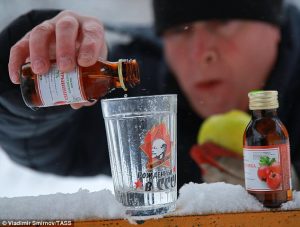 A tragedy occurred in the city of Irkutsk, in Siberia– 72 dead over a short period, all from drinking a poisonous commercial bath product.
A tragedy occurred in the city of Irkutsk, in Siberia– 72 dead over a short period, all from drinking a poisonous commercial bath product.
The label apparently bore warnings, and people should know better than to drink scented bath lotion in the first place. But other factors were in play. Besides, there’s a longstanding tradition of drinking unsafe alcohol, not only in Russia, but here in the U.S.
Why would someone consume something that’s obviously not made for drinking, and is probably dangerous or potentially fatal? The usual reason is availability. The bad stuff is at hand, and the better stuff isn’t. In that part of Russia, the price of a bottle of cheap liquor is now about $3 US, well beyond the means of many. The poisonous stuff sold for a third of that. And unscrupulous vendors suggested it actually contained ethanol, which is drinkable, rather than methanol, which is not. Once word got out, things took off. As with incidents that involve fentanyl-laced heroin or pot treated with some unidentified toxin, the consequences are swift and often permanent.
Drinking the “undrinkable” is something I’ve witnessed here, too. Watching a couple kids in high school pass a bottle of Vitalis hair tonic between them, taking sips, waiting for the buzz. Catching two patients in a locked hospital ward in the act of filtering hairspray through pieces of bread, so they could get high on it. I’ve read about inmates drinking siphoned gasoline from institutional lawnmowers, to stave off withdrawal. No, I’m not making that up.
It’s dangerous. But as one correctional supervisor admitted, his officers would turn a blind eye to prison hooch, Pruno or Raisin Jack, because “you should see what they get up to if they can’t get hooch.”
Taxation is one way that governments decrease overall consumption of alcoholic beverages. It’s a model used here in the States with tobacco. The problem: It can inadvertently fuel the growth of a black market. And because quality standards are nonexistent among illicit sources, accidental poisoning is not rare.
Once the demand for a drug is well-established, as it is for alcohol, people will find a way to get it, legal or otherwise. A better approach is to launch a broad-based effort to address use and addiction, and their diverse consequences, in a systematic, planned way.
But that takes time and effort, and comes at considerable expense. So it’s not all that popular with governments, here or in Russia. Or for that matter, anywhere else.










